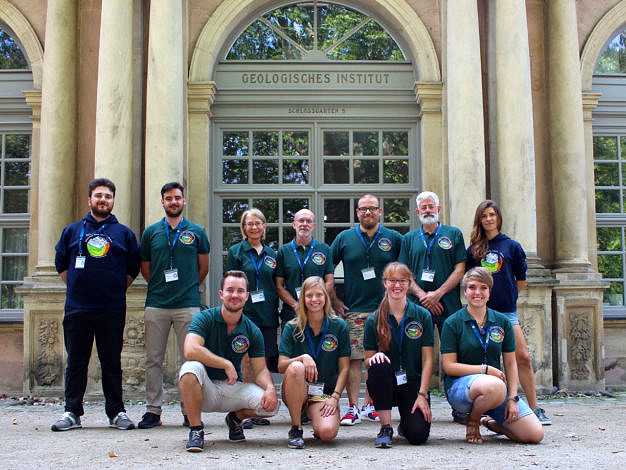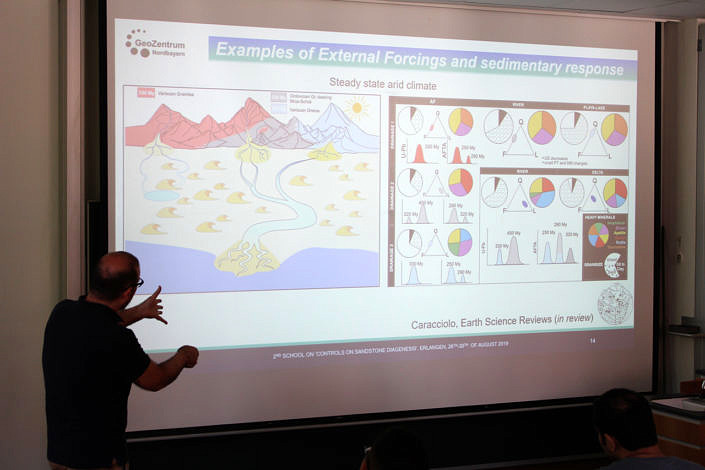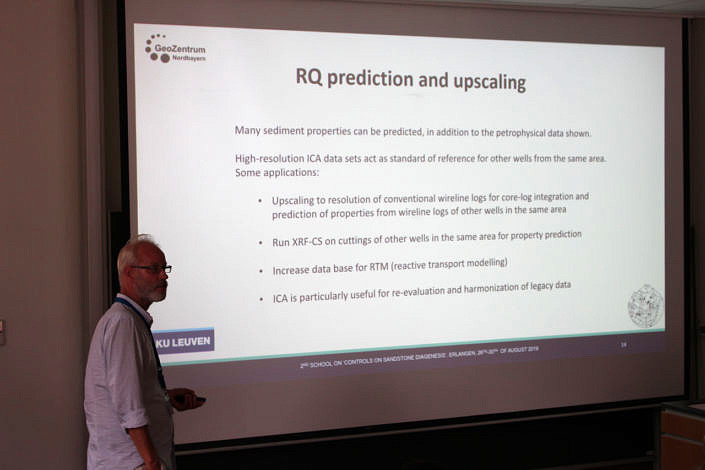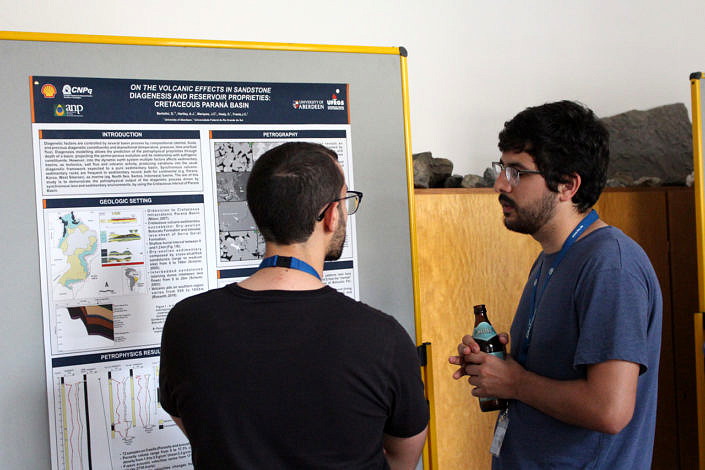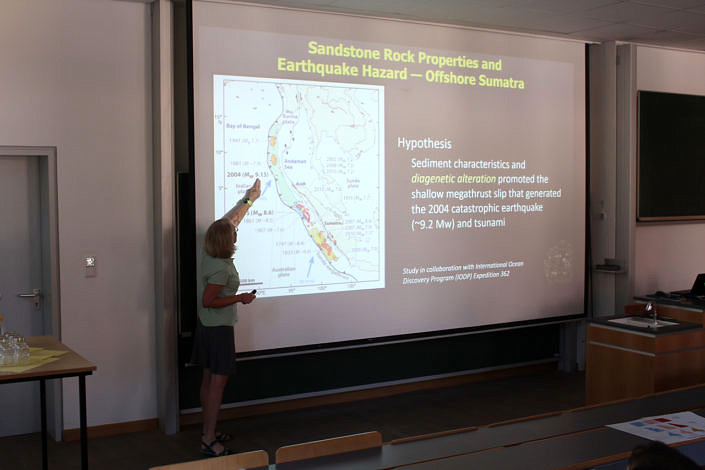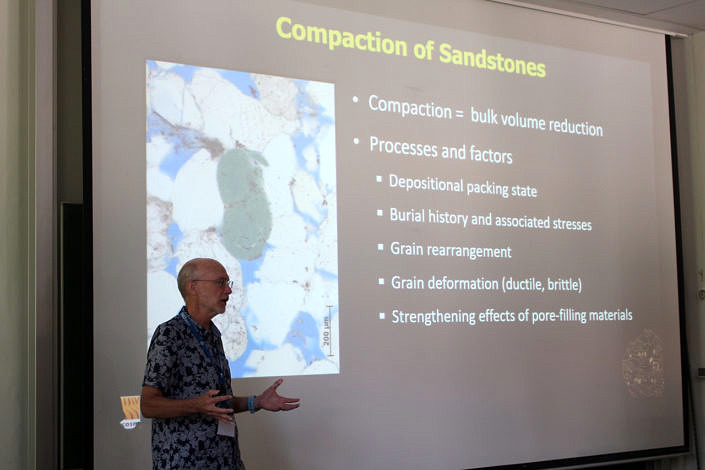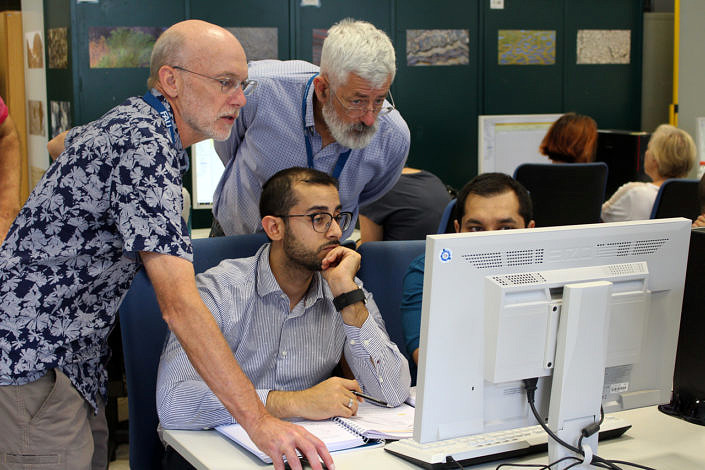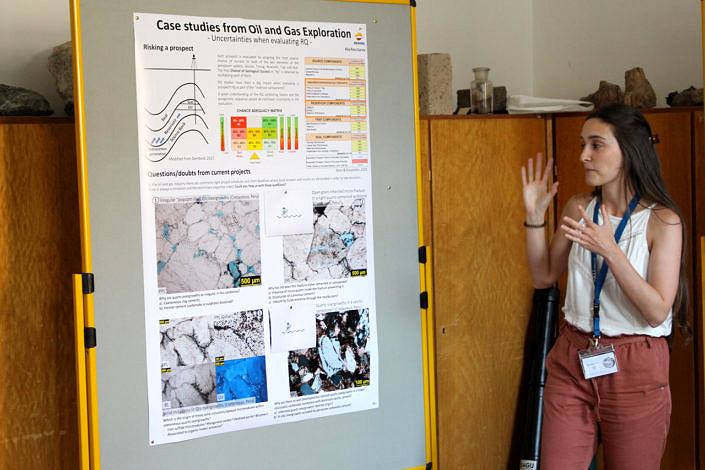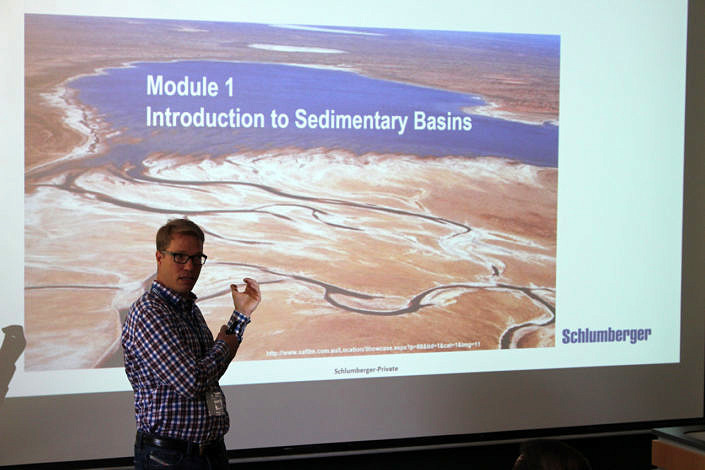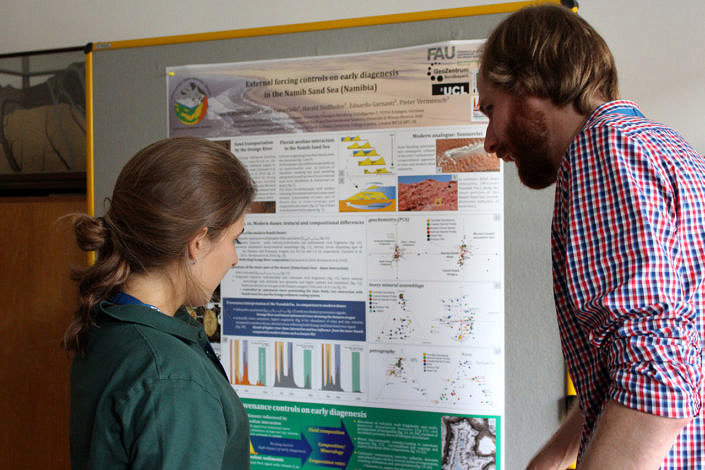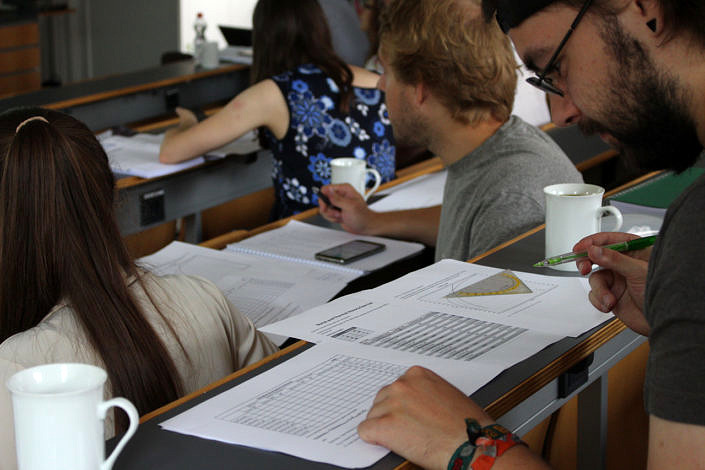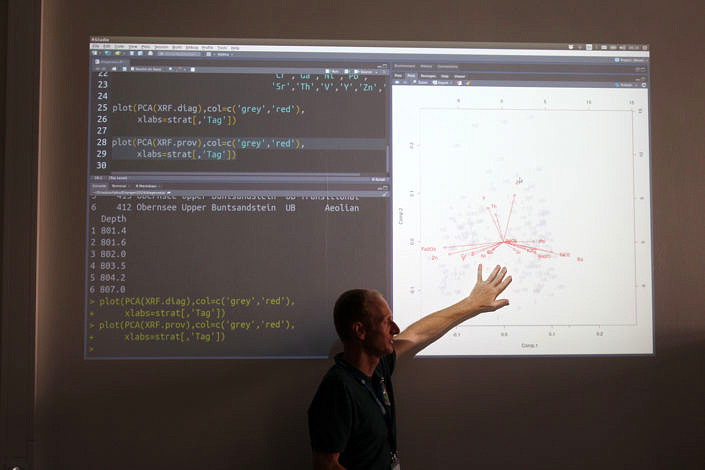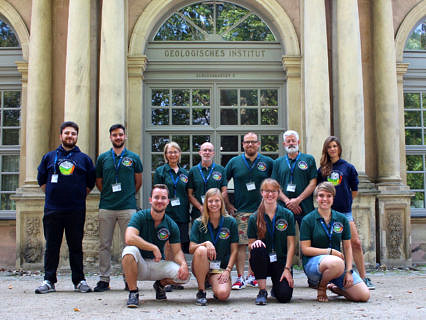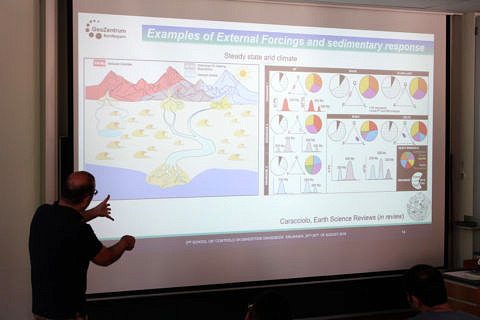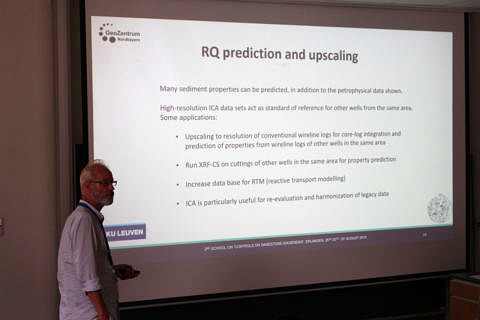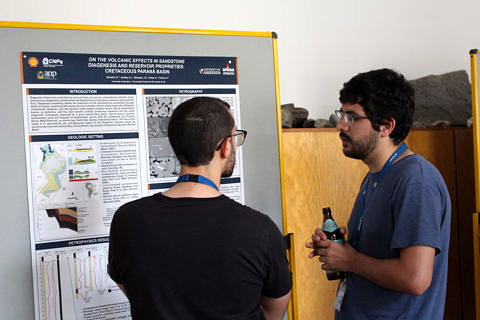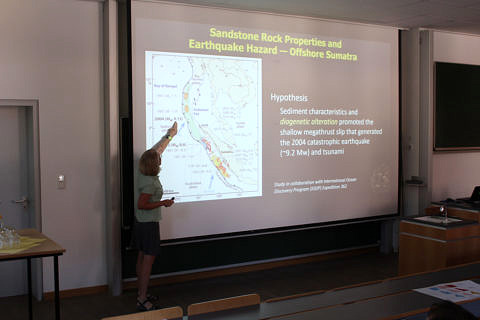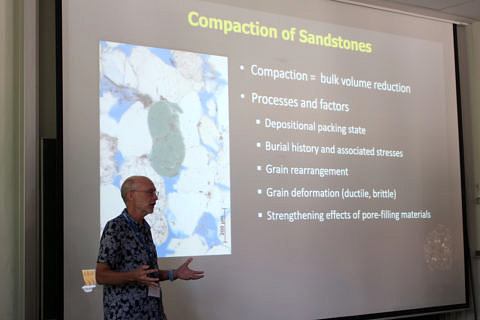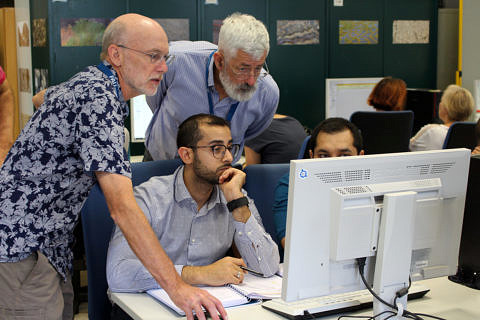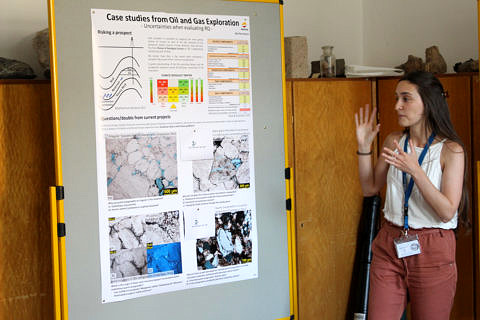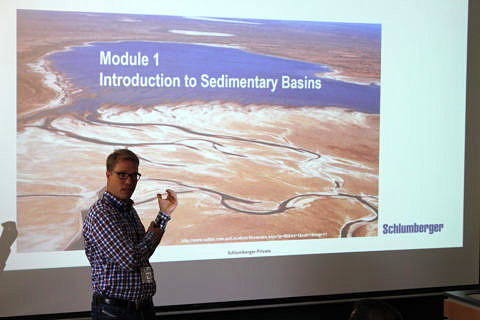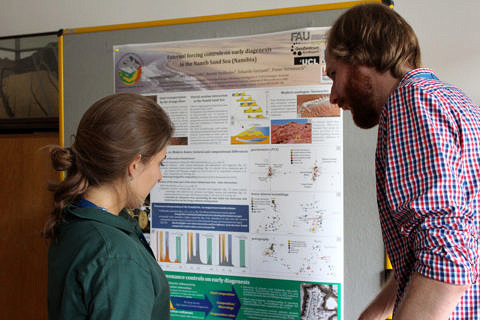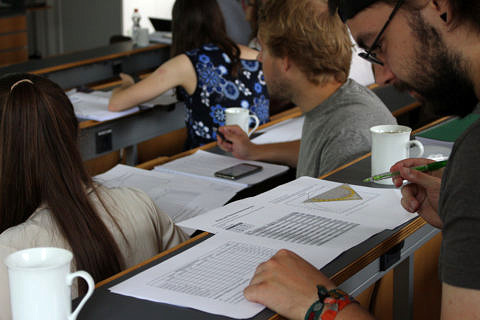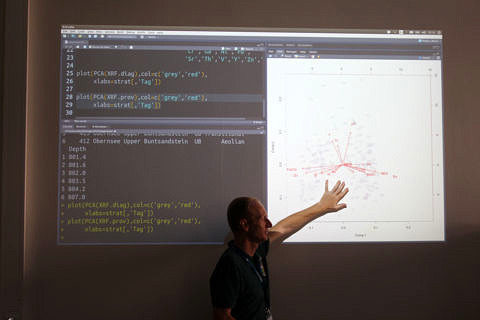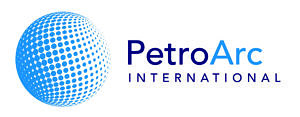3rd School on Sandstone Diagenesis
The Applied Sedimentology Group at the GeoZentrum NordBayern (FAU Erlangen-Nuremberg) and Geocosm LLC. are happy to announce the 3rd School on the Diagenesis of Silicilastic Sediments. The first and second edition were a success. We received motivated geoscientists from both University and Industry from all over the world. The third edition will be held as usual at the Geozentrum Nordbayern in Erlangen (Nuremberg, Germany). As for the second edition, the school will last for 5 days, from the 22nd to the 26th of August 2022, and will focus on both traditional and innovative concepts for controlling processes on sandstone diagenesis and their implications for data interpretation and modeling.
For the third consecutive year, the school is supported by the International Association of Sedimentologists (IAS) in the past. We greatly value their financial support to the student members that already allowed the participation of early career geoscientists from the USA, South America, the EU, and SE Asia.
Please download our flyer from the link below. We would appreciate if you could print it and advertise it in your University / Company and circulate it amongst people who may be interested in the course.
Why diagenesis?
While the definition of diagenesis – the transformation of unconsolidated sediment to rock – is easily understood, the factors that influence the nature and magnitude of this transformation are complex. In this school, we will review the state-of-the-art in our understanding of many of these factors in sandstones. Such an understanding is an essential prerequisite for accurately predicting rock properties in the subsurface and has important societal applications in topics as diverse as aquifer depletion, wastewater disposal, contaminant transport, hydrothermal energy production, and hydrocarbon exploration and production.
Why a holistic approach?
Although diagenesis in a strict sense refers to biological, chemical, and physical processes that occur after deposition, the nature and magnitude of these processes is inextricably linked to the starting composition and texture of the sediment. To date, little has been done to bring together two critical aspects of sandstone reservoir quality prediction: the controls on the depositional composition and texture and the post-depositional overprint of diagenesis. An important and novel aspect of this course is to bring together experts in these two disciplines to provide course participants with a review of both parts of the reservoir quality prediction problem.
Processes That Control Depositional Composition and Texture
Depositional composition and texture constrain fundamental rock properties such as porosity and permeability of the nature and magnitude of diagenesis from shallow to deep burial. The starting point in understanding and predicting sediment depositional characteristics is an analysis of the genetic origin of the sedimentary input. The Sediment Routing System concept is being increasingly invoked in basin analysis and related geodynamic studies, as the variable input of sedimentation through time-affected basin development, sediment accumulation and distribution, burial, subsidence, flexural rebound, isostasy, denudation and other geodynamic effects.A comprehensive understanding of sediment generation – in its broader sense – thus represents the only possible way to achieve a solid prediction of sedimentary texture and composition. Further More, its integration into a Sediment Routing System conceptual framework allows understanding and possibly predict the distribution of sediment particles within the subset of facies of a sedimentary environment, identification of sediment-induced heterogeneities, and eventually the initial composition of deposited sediments (eg, sand framework composition, clay abundance, etc.) and how this would affect early diagenesis.The ultimate composition and texture of sediments, however, depends on the provenance and final depositional environment but also on factors such as tectonic setting, climate, and transport history. Important changes in depositional composition and texture may take place even within the same depositional facies in response to variations in search factors.
Post-depositional processes
As sediments are buried they deform and alter in response to the evolving stresses, temperatures, and fluid chemistries that they experience through geologic time. The impact of these processes on rock properties can be immense. For instance, permeability in sandstones may drop by over six orders of magnitude from the time of deposition to the present-day.
The initial composition and texture influence the mechanical and chemical properties of the sediment, which in turn may lead to substantial differences in the nature and magnitude of diagenetic change through time. For instance, grain shapes, size distributions, and material properties influence the depositional packing state as well as the magnitude of compaction that occurs in response to stress and the geochemical reactions that take place as a function of time and temperature. In the course we will review controls on depositional packing state, compaction, and reactions involving carbonates, clay minerals, and quartz overgrowths, among other diagenetic processes.
Models
Models serve as a means to encode and test our understanding of nature and have the potential to serve as an accurate basis for prediction. In the course we want to consider two broad groups of models associated with sandstone reservoir quality prediction. The theory of spatial distribution of compositional and textural characteristics of sands. The second group of models includes the post-burial lithification of sandstones in light of the depositional composition and texture and in response to the cumulative effects of stresses, temperatures, and fluid compositions through geologic time. Models that link the predicted composition and texture of diagenetically altered sandstones to properties of interest in fluid transport, geomechanics, petrophysics, and geophysics are thus an important component of this group.
This is year we have included a set of lectures and exercises focusing on a third group of model: Basin analysis and modeling. Our new partner Schlumberger will provide experts in the fields of (i) basin-forming mechanisms and basin fill, (ii) pressure and compaction in sediments, (iii) temperature and temperature history of sedimentary basins, iv) application to hydrocarbon generation, migration and accumulation, and (v) predictive methods.
List of topics
The final program will be available from the 1st of July (2021)
Sediment factory, dispersal and deposition
L. Caracciolo (FAU), William A. Heins (Getech)
- External forcing controls on sediment properties
- Modeling of controlling factors for property prediction
- Depositional facies controls on early diagenesis: texture and composition
- Accounting for genetics in Hydrocarbon exploration
- Using genetics to select analogs
Sediment composition and diagenesis
L. Caracciolo (FAU), William A. Heins (Getech), G.J. Weltje (KU Leuven)
- Sediment compositional modeling as key to controlling factors
- Compositional modeling of geochemical data and application to diagenesis
- Integrated core analysis for reservoir quality prediction
- Low-temperature (bio)chemical processes during and shortly after burial
- Chemical and mechanical processes during burial
Following the diagenetic pathway from sediment to rock
LM Bonnell, RH Lander (Geocosm LCC)
- Sandstone diagenesis and reservoir quality: an overview
- Petrography, petrology, and petrophysics
- Compaction: mechanisms of bulk volume loss
- Non-quartz cements and secondary porosity
- Clay minerals: friend or foe?
- Quartz cementation: controls and predictability
- Reservoir quality prediction: approaches and examples
Petrographic analysis
RH Lander, LM Bonnell (Geocosm LCC)
- Measuring porosity: dealing with the third dimension
- Common cement types
- Tips for differentiating replacement from cement
- Grain size and sorting
- Measuring grain coat coverage
Integrated Compositional Data Analysis and Diagenetic Modeling Workshop
L. Caracciolo, WA Heins, R. Lander, L. Bonnell, GJ Weltje and P. Vermeesch
- Compositional data analysis (data transformation, exploration and processing)
- Data processing techniques
- Case study: core data analysis and integration of petrographic, geochemical, mineralogical and petrophysical data
- Diagenetic modeling
Course leaders
Dr. Luca Caracciolo (FAU Erlangen-Nuremberg)
His research focuses on the application of a broad spectrum of Provenance analysis techniques applied to basin analysis, particularly on the relationships between tectonics and sedimentation. Most relevant analytical approaches and research interests are quantitative sedimentary provenance analysis; Sedimentary petrology and heavy minerals, detrital geochemistry, sedimentary processes (weathering / recycling, sorting and volcaniclastic sedimentation) diagenesis (cementation chronology, pore-water interaction, thermal history), Low-temperature thermochronology (Fission tracks and U-Th / He dating) , Raman and QemScan – and model compositional data to link sediment mineralogy to pre- and post-depositional sedimentary processes.
The applied side of his research involves provenance and sediment composition in different fields, especially those related to the O&G and geothermal industry for enhanced interpretation of facies heterogeneity, reservoir connectivity, diagenetic environments and their influence on fluid migration. Combining both academic and industry experience, I had the chance to work and publish in areas dislocated in all continents including Europe, North and South America, Africa, SE Asia, Australia and New Zealand. I’m actively involved in industry projects and training of professionals from the O&G industry. He is actively involved in industry projects and training of professionals from the O & G industry. Chief editor for the special volume of sedimentary geology ” sediment generation and provenance: process and pathways ” and the forthcoming ‘Sediment Generation and Sediment Routing Systems’ on Earth Science Reviews.
Dr. Linda M. Bonnell (Geocosm LCC)
Partner / Scientific Advisor
Linda Bonnell is deeply involved in Geocosm’s geoscience research efforts and leads many of the company’s reservoir quality prediction and risk assessment studies. She has been instrumental in the development of Geocosm’s Touchstone and Cyberstone systems for reservoir quality assessment.
Linda was an AAPG Distinguished Lecturer in 2003 and 2004 and has published a number of abstracts and papers touching on various aspects of diagenesis in peer reviewed journals, including one that received the Wallace E. Pratt Memorial Award for best paper in the AAPG Bulletin in 2010.
Linda earned her Ph.D. in Geology from the University of Illinois in 1990 where she worked with Tom Anderson and subsequently held Research Associate positions at Washington University and Rice University where she worked with Lynn Walter and Rob Dunbar, respectively. She was a Senior Research Scientist with Rogaland Research in Stavanger, Norway from 1993 until 1997 when she joined Geologica AS, a spin off company. Linda co-founded Geocosm LLC in 2000 and holds the positions of Scientific Advisor and Partner. She also has an appointment as a Research Fellow at the John A. and Katherine G. Jackson School of Geosciences at the University of Texas at Austin.
Dr. Robert H. Lander (Geocosm LCC)
Partner / Scientific Advisor
Rob Lander works with diagenesis and petrophysical models for Geocosm. He co-invented Geocosm’s Prism2D, Touchstone, and Cyberstone models and Geologica’s Exemplar® model. Rob has published more than a dozen scientific papers in peer reviewed journals in the past 10 years and is the author of four “notable papers” in the AAPG Bulletin, including one that received the Wallace E. Pratt Memorial Award for best paper. He was an AAPG Distinguished Lecturer in 2015, co-edited a special issue of the AAPG Bulletin on sandstone reservoir quality prediction in 2010, and co-convened a Hedberg Conference and a meeting hosted by the Geological Society of London.
Rob obtained a Ph.D. in Geology from the University of Illinois in 1991 under the supervision of Dick Hay and was a Senior Research Geologist at Exxon Production Research from 1991 to 1993. He then joined Rogaland Research in Stavanger, Norway and was one of the founding staff members of a spin-off company (Geologica AS) in 1996 where he held the position of Scientific Advisor and later as Technical Director. Rob co-founded Geocosm LLC in 2000 where he is a Scientific Advisor and Partner. He also has an appointment as a Research Fellow at the John A. and Katherine G. Jackson School of Geosciences at the University of Texas at Austin.
Dr. William A. Heins
Bill Heins is a sedimentary geologist focused on the relationship between the genetic environment of sediments in the hinterland and reservoir quality in the basin. At ExxonMobil Upstream Research Co., Bill helped develop the patented SandGEM system for predicting sand composition and texture as inputs for reservoir quality forward models like Touchstone. As Product Ambassador for Getech’s Globe Knowledge Base, Bill helps petroleum companies use paleogeographic and paleoenvironmental reconstructions to understand the geographic and stratigraphic distribution of hydrocarbon play elements. Prior to working as an Earth scientist, Bill was a consultant for the Strategic Management Group of Philadelphia, which advised large technology-oriented multinational companies on competitor analysis and strategy formulation.
Bill earned a PhD in Geology from the University of California, Los Angeles in 1992, as well as a BA in Geology from the College of Arts and Sciences and a BS in Economics from the Wharton School of Finance, at the University of Pennsylvania in 1984.
Invited Speakers
Prof. Gert Jan Weltje (KU Lueven)
Gert Jan Weltje studied Earth Sciences at Utrecht University (NL), where he obtained his PhD in 1994, on inverse (numerical-statistical) modelling of sediment composition for provenance analysis. After this, he worked for several years as a post-doc on Sedimentary Geology (Vrije Universiteit Amsterdam, NL), Applied Nuclear Physics (Groningen University, NL), and as independent sedimentological-statistical consultant for various E & P companies and the Dutch Ministry of Health Transportation and Water Management. In 1997, he received the Biennial Vistelius Research Award from the International Association for Mathematical Geosciences for Outstanding Contributions to the Application of Mathematics in the Earth Sciences. Between 1997 and 2002 he was employed as a senior researcher at reservoir geology at TNO and assistant professor of mathematical geology and clastic sedimentology at Delft University of Technology where he became a full-time associate professor in 2002. Between 2006 and 2013, he was editor- in-chief of the journal Sedimentary Geology and Scientific Adviser of the marine geoscience research MARUM in Bremen (GE). He has been a Research Fellow in Ocean and Climate Science at the Hanse Institute of Advanced Science (GE) since 2007, and is a professor of reservoir geology at the Politecnico di Torino (IT) since 2013. In 2014, he was appointed full professor of Sedimentary Systems at KU Leuven (BE), where he has been director of the educational program in geology since 2017. His research interests center on numerical modeling of siliciclastic basin fills and (geo) statistical analysis of their properties for the purpose of provenance analysis, paleo-environmental reconstruction, mass-balancing studies, and reservoir-quality prediction and acted as guest editor of five special issues of the journal Sedimentary Geology.
Dr. Pieter Vermeesch (UCL London)
Pieter Vermeesch is a Reader at Geochronology at University College London (UCL) and co-director of the London Geochronology Center (LGC). His research interests include geochronology, thermochronometry, (geo) statistics and aeolian geomorphology using the U-Pb, Ar-Ar, fission track and U-Th-He methods. Dr. Vermeesch develops novel ways to generate and interpret ‘Big Data’ for sedimentary provenance analysis, by combining detrital geochronology with mineralogical and chemical provenance tracers. He has developed a suite of free and user-friendly software to make the tools available to the geosciences community.
Registration
The school aims at offering both a high-quality training program and deep interaction between attendants and course leaders. Therefore, seats for the school are limited to 30. The time window for submitting your application is between the 1st of February and the 31st of March 2019.
Admission
(1) A short CV and (2) a Cover Letter (max 500 words) including the main research aspects of the candidate along with a motivation for attending the school in view of project and / or career development.
Evaluation criteria are:
- Quality of the application, including English (spoken and written).
- Evaluation of the cover letter explaining how the school is relevant to project / career development; project / career development;
- Global representation
Costs and deadlines
The time window for submitting your application is from the 1st of February to the14th of March 2021. The school board will notify the acceptance to successful candidates by no later than the 15 th of April. Participation fees will need to be transferred by no later than the 15th of May. In case of non-received payment, the school will contact other applicants in order to guarantee the participation of as much attendees as possible.
Participation fees
Ph.D. students 500 €
Post-docs 800 €
Professionals from the industry 1500 €
Please send your application to luca.caracciolo@fau.de
Erlangen offers a wide range of accommodation, ranging from guesthouses to 4 star hotels that are easily accessible from the main train station and are walking distance to the GeoCenter .
Our recommendations are:
City Center
Outside the city center (easily reachable by bus)
The GeoZentrum NordBayern is located in Schlossgarten 5, in the heart of Erlangen, a small but historical city located 20 minutes from Nuremberg.
Nuremberg airport is connected to all European capitals and to a large number of EU cities. Erlangen can be easily reached from the airport by bus (number 30 towards Erlangen Arcaden). The transfer takes approximately 35 minutes. Alternative options are available via Nuremberg. The U2 metro line connects the airport to Nuremberg Central Station (main station) in less than 15 minutes. From there, the train to Erlangen takes about 18 and 28 minutes depending on the train type.
Erlangen is located between the two major airports in Germany, Frankfurt and Munich which are connected to Nuremberg / Erlangen with both airplane and trains.
Frankfurt airport has a train station served by high-speed long distance trains ( long distance trains – ICE ) in about 2 hours.
Munich Airport is connected to Munich Central Station by metro and is reachable in about 40 minutes. Connection frequency between Munich and Nuremberg is about 1 hour.
Both the Deutsche Bahn website and application for mobile devices are extremely helpful at the time of planning your trip.
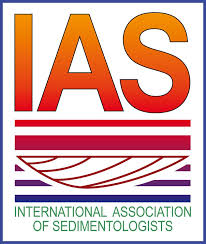 IAS is a truly international association. It has about 2000 members from about 100 countries and national correspondents in more than 50 countries. On 14 November 2016, IAS obtained a new legal status as an International Non-Profit Organization, under Belgian law. Founding members are Judith A. McKenzie, Finn C. Surlyk, Adrian M. Immenhauser, Poppe L. de Boer, Vincenzo Pascucci and Marc AO De Batist.
IAS is a truly international association. It has about 2000 members from about 100 countries and national correspondents in more than 50 countries. On 14 November 2016, IAS obtained a new legal status as an International Non-Profit Organization, under Belgian law. Founding members are Judith A. McKenzie, Finn C. Surlyk, Adrian M. Immenhauser, Poppe L. de Boer, Vincenzo Pascucci and Marc AO De Batist.
IAS publications include volumes of the Sedimentology , The Depositional Record , Basin Research and Petroleum Geology , Newsletters, Special Publications, Guidebooks for the International Sedimentological Congresses and Regional Meetings.
IAS publishes the journal Basin Research in collaboration with the European Association of Geoscientists and Engineers (EAGE) .
